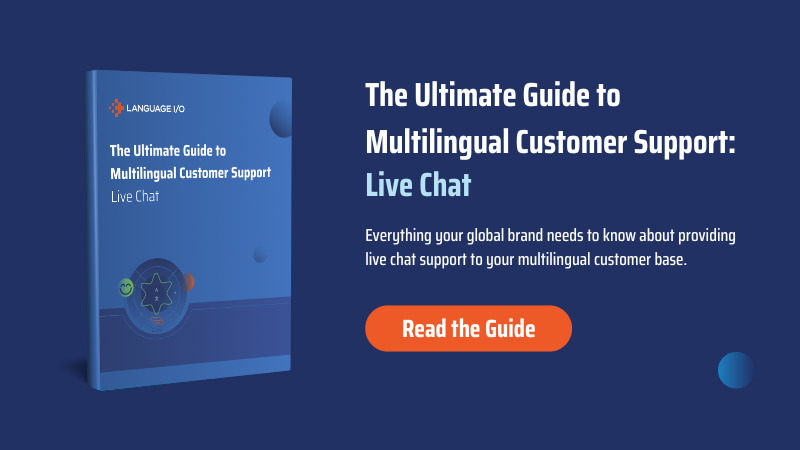Rules-Based vs. AI Chatbots: Choosing the Right Chatbot for Your Business
Is an AI chatbot right for your business, or are you better served by one that’s rules-based? Here’s a breakdown of the key differences and how to choose one for your organization.
Subscribe to our newsletter
Share
Organizations around the world are increasingly using chatbots to support marketing, sales, and customer service operations. It’s no surprise why; chatbots improve the customer experience in a number of critical ways, such as allowing customers or prospective buyers to communicate with a brand on a 24/7 basis, without having to wait in a queue while agents serve other customers. Multilingual chatbots are also an attractive option for businesses looking to support a global customer base that speaks various languages.
As businesses develop and launch chatbots on their websites, many considerations must be taken into account. One of the key decisions to make early on is whether to deploy a chatbot that is rules-based or one that is powered by AI. Keep reading to learn the key differences between the two kinds of chatbots, and how to determine which one is best for your business.
Rules-Based vs. AI Chatbots: What is the Difference?
While chatbots are often associated with conversational AI, not all chatbots actually power off of AI. Chatbots that don’t use AI are typically considered ‘rules-based.’ Rules-based chatbots follow a decision tree matrix to guide customers to a specific action. The rules powering this chatbot and the associated script used by the bot are determined in advance, such that they do not change without manual action on behalf of the organization building the chatbot.
Rules-based chatbots tend to function similarly to how a phone system’s interactive voice response (IVR) does, in that customers are presented with a series of options (in the case of the chatbot, these take the form of buttons) and can select the one that is best for them. When a customer chooses an option, this triggers a designated follow up action to occur, sometimes one with another set of options from which the customer can choose.
AI chatbots, on the other hand, are those that are indeed powered by artificial intelligence. AI chatbots use natural language processing (NLP) technology not only to understand what a sentence says, but to understand the meaning behind the sentence. This gives the chatbot what it needs to determine the intent of each message, which in turn allows it to respond in a way that is most helpful to the user. Unlike rules-based chatbots, AI chatbots don’t stick to any one script. Instead, they learn from data that helps them craft responses based on customer inputs, and improve over time as they gather more data from each interaction.
Choosing the Right Chatbot for You
Determining which type of chatbot to use depends on a number of factors, which may include:
- What your organizations seeks to accomplish via chatbot
- Time and resources available to develop the bot
- The scope of customers’ most frequent needs and related questions
- Access to first- or third-party data
For brands who simply need a bot that can provide automated support about a few key aspects of the business, such as where to find information about returns & exchanges, or how to change the password of an account, a rules-based chatbot is more than likely to fit the bill. Rules-based chatbots require much less investment than AI bots, as they do not need to be trained via first- or third-party data, nor do they need to undergo a learning period.
When implementing a rules-based chatbot, expectations must be set accordingly. Your internal team should still expect that many inquiries made with the chatbot will need to be escalated to a human agent; as such, the bot must always have a way of connecting customers to a live representative. In the event that the conversation is taking place outside of normal business hours, the chatbot should have a mechanism in place to capture the customer’s contact information and surface it to an agent when they are back online.
For organizations looking to deploy a chatbot that can function almost at the same level as a human agent, in that it can resolve a variety of issues ranging in complexity on its own, then an AI chatbot is the way to go. AI chatbots require more investment, both in terms of time and cost, but they perform at a higher level than their rules-based counterparts. While well-trained AI chatbots can solve a higher rate of questions and issues on their own, the option to connect a customer with a live agent should still be available in order to satisfy customer preferences.
Whether Rules- or AI-Based, Don’t Forget About Global Customers
The vast majority of chatbots, both rules-based and AI-based, are available in English only. While this presents an option for those who speak English as a first or second language to use the chatbot, it excludes non-English speaking customers from the equation. For brands whose audiences are global or in regions where English is not the primary language used, providing the same quality of chatbot support to customers regardless of their preferred language should be a priority.

It’s understandable why brands are hesitant to create a chatbot across the various languages spoken by customers. Deploying a chatbot in one language can be a challenge—duplicating it into multiple languages may seem impossible. But with the right technology in place, making your existing chatbot multilingual, no matter whether it’s rules-based or an AI chatbot, doesn’t have to be a difficult process.
At Language I/O, we make it easy to take your current chatbots and make them communicate with customers in more than 150 languages. Reach out to us to learn more about how to turn your existing chatbot into a polyglot overnight.
